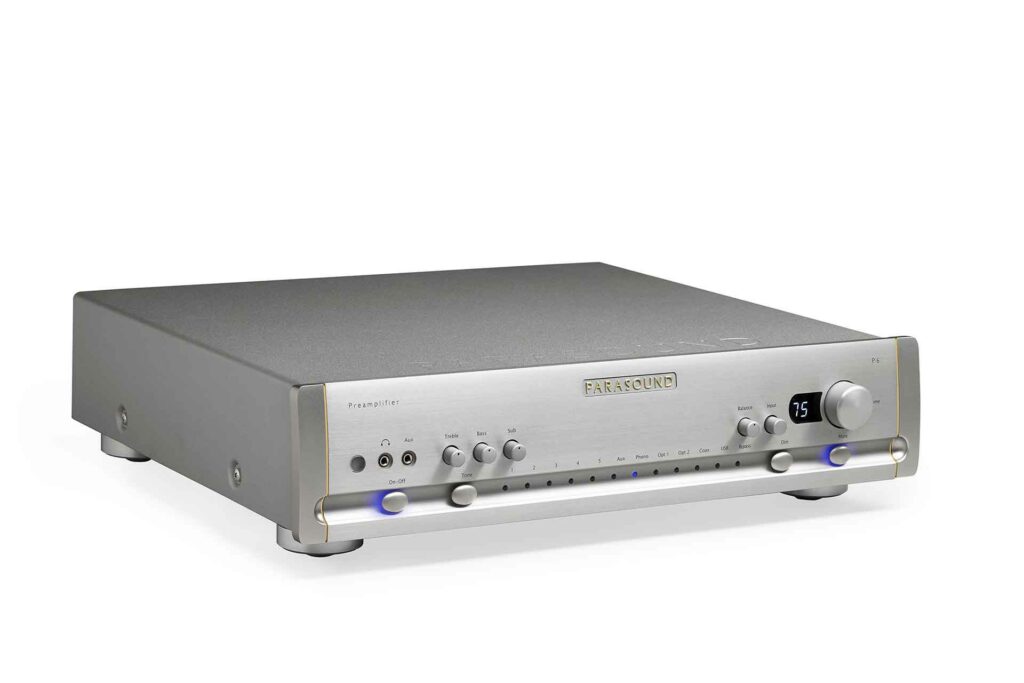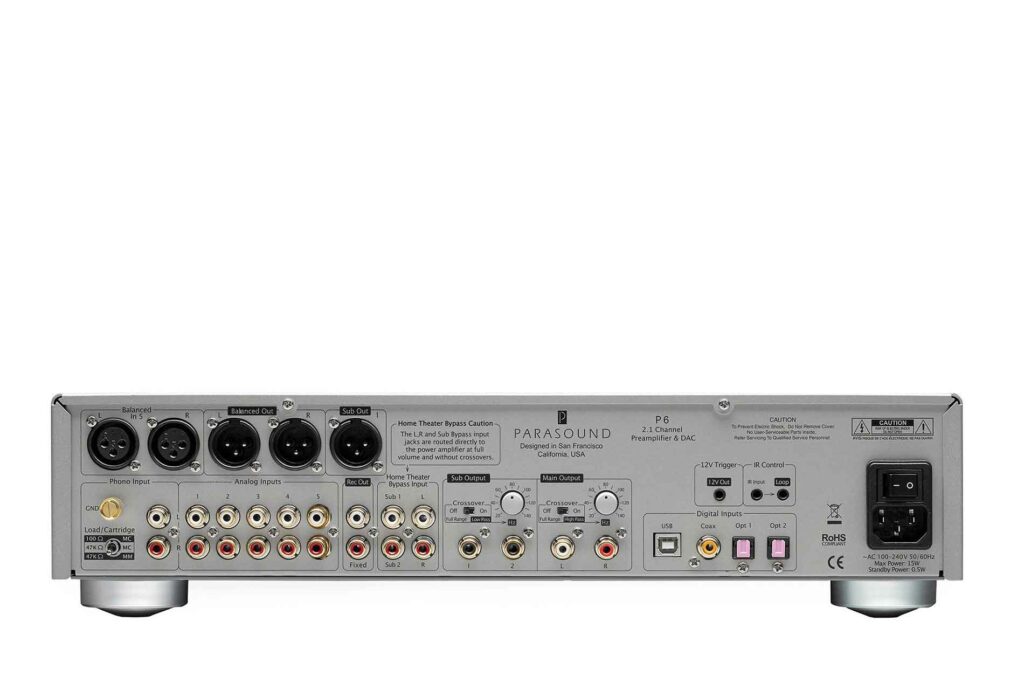Parasound has been offering high-value audiophile gear for three generations now, including many higher-end products designed by legendary consultant John Curl. Today, they offer a broad range of products, including some revered integrated amplifiers, but if you’re looking to move beyond a one-box solution into a full-blown component system with outboard amplification, the Parasound Halo P 6 is a compelling solution that manages to appeal to virtually every type of audio enthusiast except for those who wouldn’t touch anything other than a flea-watt tube-powered system. Let’s explore why this Swiss Army knife of an audiophile preamplifier that can seemingly do it all.

What Makes the Parasound Halo P 6 So Special?
- The Parasound Halo P 6 is a low-noise, high-performance line stage preamp above all else.
- Included within the chassis of the Halo P 6 is a Burr-Brown analog resistor ladder volume control. This simply means volume is controlled by dedicated, high-precision resistors. This configuration avoids the mechanical contacts of relays or metal-to-resistive metal scraping of potentiometers. In short, the advanced volume control offers extremely low noise, while providing an (audio-log) taper that allows for very fine control through the levels where most people enjoy their music.
- The Halo P 6 offers a wealth of inputs for its price, including a good amount of analog inputs, which are becoming less common these days. There are five sets of stereo RCA ins, one set of stereo balanced XLR ins, and your choice of single-ended or balanced outputs. The Halo P 6 even offers an auxiliary input on the front panel that has extra gain built-in for low gain devices.
- There is a killer phono stage built right into the Parasound Halo P 6 stereo preamp. There are accommodations for Moving Magnet (MM), Moving Coil (MC), or even Moving Iron (MI) cartridges, with 100 Ohm or 47K Ohm loading. This flexibility allows the advanced phono stage to blossom before sending your music over to the preamplifier section of the P 6. There are capable phono preamps out there in the $200 to $500 range, but having one this good built into your $1,599 stereo preamp is a big plus.
- The powerful ESS Sabre32 DAC in the Halo P 6 will decode just about any digital source via the USB input coax, or optical inputs. For Native DSD 64, DSD128, DSD256, and DoP DSD, the USB input is used to deliver up to 384 kHz / 32-bit PCM. The Coax and optical inputs accept PCM up to 192kHz/24-bit.
- Advanced bass management is available to cross your speakers over with a subwoofer seamlessly. Unlike most stereo gear, the P 6 even allows you to adjust the crossover via the rear panel, and you can set different high-pass and low-pass frequencies for your main outputs and subwoofer outputs independently.
- The Parasound Halo P 6 stereo preamp also comes with a high-current headphone amplifier based around the Texas Instruments TPA6120 integrated circuit, which is well respected in the design community. You can see why I made the Swiss Army knife reference earlier, right?
Why Should You Care About the Parasound Halo P 6 ?
The Halo P 6 represents an unparalleled value because it would be nearly impossible to buy separate components that perform as well as each of its built-in features for less than perhaps double that of its selling price. This is appealing for any audiophile on a budget, for anyone assuming a secondary system as well as those looking to downsize a system without compromising performance or any key features. Parasound backs the Halo P 6 with a five-year warrantee, which is a bold showing of confidence in their product’s reliability. Just make sure you buy it from an authorized dealer, as Parasound is understandably militant about that.

Some Things You Might Not Like About the Parasound Halo P 6
- The Halo P 6 does not offer the sort of modular expandability offered by some of its competition. While it likely offers all the connectivity you need for modern components, adding inputs or outputs for future format support would require the development of a P 6mkII.
- The remote feels a little chintzy. It’s a nice-enough piece, glows a lovely blue, and is full-function in terms of performance. Unfortunately for those who like elegance, it is a giant plastic block of a thing that is reminiscent of a 1990s universal remote. I guess you have to keep the costs down somewhere, right?
- The DAC in the Halo P 6 lacks some updated features. The Halo P 6 was released a few years ago now and because of this, it lacks the ability to decode MQA files. Also, Bluetooth functionality would be nice. Bluetooth might not be most audiophiles’ choice for serious listening; however, having the stereo rig on in the background is always nice so that you can get the most out of your system day-in and day-out.
Listening to the Parasound Halo P 6 Preamplifier…
Throwing the Rega P1 turntable onto the phono input yielded great sonic results. Stevie Ray Vaughan (SRV) is no stranger to most music lovers. His hit album Texas Flood was released in 1983 and the title track is one of my favorites. The wide imaging and great spatial relationships between the band was alluring. There was plenty of resolution too, and it helps make the complexity of SRV’s handwork on the guitar more intelligible.
Running Qobuz into the Parasound Halo P 6 afforded the opportunity to stretch the internal DAC’s legs a bit. If you are fortunate to have big ol’ speakers, or a well-tuned small-speaker-and-subwoofer combo, the 96Khz/24-bit recording of the 2018 album Vicious by Halestorm is quite the metal treat. The debut track “Uncomfortable” is just that – dirty, gritty, and an intense run through social norms with both middle fingers blazing through the air. Lizzy Hale’s vocals are as clean as her brother Arejay’s high-intensity drumming. There is a dirty little secret about most heavy metal recordings: If all they sound like is noise, then the system in which the music is being listened to has glaring flaws.
The Parasound Halo P 6 was up to the task. The guitars had texture and dynamic presence, and Lizzy’s voice and harmonies locked in the front with all the authority you would expect from the frontperson of a metal band. The drums were tight, and nothing lingered long enough to miss the blazing pace of this track. When I listen to this one on my reference system, I do get a little greater sense of space and dynamic range than I got with the Halo P 6, but this is splitting hairs given that the Halo P 6 retails for 15 times less than my DAC/Preamp combination.
In order to evaluate the Halo P 6’s capability as a straight preamplifier, I hooked it up to a nearly $10,000 Bricasti M1 DAC using balanced XLR cables. Doing so allowed a 1994 favorite to really shine. Pearl Jam’s Vitalogy features the haunting track “Nothingman,” which hits home with its waltzy pace and intimate harmonies. As a preamplifier, the Halo P 6 imparted very little to the sound other than the ongoing themes discussed above. Even when presented with the opportunity to fail, the Halo P 6 chose to shine instead, resolving the strong harmonies during the chorus over a backbeat rhythm and undistorted electric guitar. It was very impressive to see the Halo P 6 perform so well, but this is not surprising from Parasound.
Does the Parasound Halo P 6 Have Any Resale Value?
Parasound products do very well in the used market, typically retaining 50 percent or greater of their original retail value for the first five years. That the Parasound P 6 has so many features helps the future value of the product, as well. The company has good distribution but isn’t known for their marketing, which doesn’t help people know that they want to own it, though. Too many audiophile companies think in this engineering-first way, sadly.

Who Is the Competition for the Parasound Halo P 6?
The $1,000-to-$2,000 market for high-fidelity electronics is crowded in every category. Preamplifiers are no exception.
Saving a couple of hundred bucks ($1,399) will put the Rotel RC-1572 MKII (buy at Crutchfield) on the stereo rack. The Rotel has a DAC that is as capable but yields to the Halo P 6 in the phono stage, since it only accepts MM cartridges. The Rotel also lacks the sophisticated volume control of the Halo P 6, and features no bass-management capabilities.
Continuing this theme, for a few hundred dollars more ($2,099) you can get into the Rotel RC-1590 MKII (buy at Crutchfield). There is a superior DAC included in the Rotel RC-1590 and it offers more connectivity than the Halo P 6. However, there is still only accommodation for a MM phono stage. The RC-1590 also has more sophistication in the power supply and has lower published distortion than the Halo P 6, although the distortion of both is insignificant.
Final Thoughts on the Parasound Halo P 6 Preamplifier
The Halo P 6 preamplifier can do it all when it comes to a preamp – if it is even fair to call it merely a preamp, as it is also a higher-end DAC, capable phono stage, headphone amp, and bass management device. The Parasound P 6 stereo preamp offers a functional level of features that are no-compromise, which is amazing at its price. Call me crazy, but I could argue that the DAC in the Halo P 6 alone is worth the $1,699 selling price. Add to that a flexible and capable phono stage, along with bass management and a high-quality headphone amplifier, and the Halo P 6 is truly a hard-to-beat value with loads of useful features.




Hello, I’m looking at the Parasound Halo P6 and the Rotel RC-1572 MKll preamps. In your opinion is there a distinct sound difference (profile) between the two? Are they completely different sonically?
Thanks,
David
Thanks for the question.
A good preamp shouldn’t have much of a sonic signature. These are cost-no-object units but they don’t have an obvious sound.
For me, personally, I think the uncertainty behind the all-engineering no-marketing strategy from the new owners at Parasound is somewhat concerning. Building a better mouse trap MIGHT have worked when I was in diapers back in the late 1970s but not today thus I have concerns about long term value. Rotel is owned my McIntosh Group and rock solid. Both products are very good. NAD would come into the conversation too for me. Perhaps Cambridge Audio.